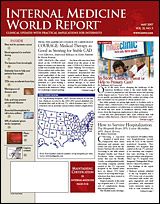Rosiglitazone May Accelerate Bone Loss, Increase Osteoporosis Risk
Impact Seen in Women, Not in Men
Endocrinology
The thiazolidinedione (TZD) rosiglitazone (Avandia) may accelerate bone loss in older patients with type 2 diabetes, which in turn would increase their risk for osteoporosis, according to preliminary results of a new study (. 2007 Mar 1.).
It was previously thought that patients with type 2 diabetes were protected against osteoporosis because of the weight gain associated with diabetes and with some of the therapies, including TZDs. However, new evidence suggests that although bone density is greater in patients with type 2 diabetes, so is the incidence of fractures in this patient population.
N Engl J Med
J Clin Endocrinol Metab
Data from 2 recent studies unexpectedly demonstrate that rosiglitazone places women in particular at increased risk for bone fractures in the upper and lower extremities (. 2006; 355:2427-2443; . 2007; 92:1305-1310). In February, GlaxoSmithKline sent a letter to physicians detailing this new finding related to rosiglitazone use that applies to women; the data did not show similar effects on men using this drug.
This new study looked at the effects of rosiglitazone on the skeleton of growing (1 month), adult (6 months), and aged (24 months) C57BL/6 mice. The C57BL/6 mouse strain is a frequently accepted model for bone aging.
All mice were fed a diet supplemented with rosiglitazone for 7 weeks. The average daily dose of rosiglitazone did not vary significantly between the groups, but there were significant differences in cumulative doses, with young animals receiving the largest cumulative dose (916.3 μg) and older mice receiving the smallest (788.9 μg).
Results showed that, at least in animals, the mechanism of TZD-induced bone loss may differ according to age and skeletal status. The bones of young, growing mice were least affected, although they did have a decreased rate of bone formation. But bone volume was significantly decreased in the adult and aging mice that were given rosiglitazone.
IMWR
“At this point, it is unclear whether similar correlations will take place in humans. If the mechanism of bone loss due to TZDs is different in younger and older individuals, then personalized therapy to prevent bone loss should be considered,” Beata Lecka-Czernik, PhD, study coinvestigator and associate professor, Department of Geriatrics, University of Arkansas for Medical Sciences, Little Rock, tells .
These results indicate that patients, especially older postmenopausal women, should be told about the potential risk for bone loss with TZD therapy, Dr Lecka-Czernik stresses. She also advises that “physicians should monitor closely skeletal parameters of these patients.?Monitoring may include measurements of urinary or serum bone turnover markers and periodic DXA [dual-energy x-ray absorptiometry] scans of their skeleton.”
Based on this new information, physicians should alert their patients who are already taking rosiglitazone of this potential adverse effect and the importance of monitoring their skeletal health, Dr Lecka-Czernik notes.
“More research has to be done to determine whether commonly used bone anabolic and antiresorptive therapies can be used in combination with TZDs to prevent bone loss,” she said.
TZD therapy has been shown to improve glycemic control and is now widely used for the treatment of diabetes; however, the TZDs’ potential adverse effect on bone health requires extra caution when prescribing any of these agents in women, especially in older women.
